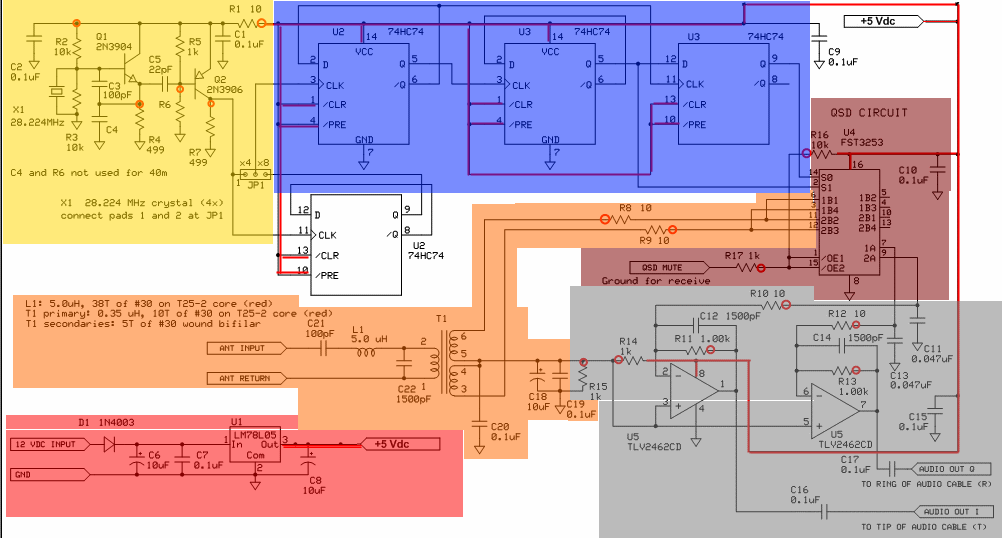Home BOM PS LO DIV Op-Amp RF Mixer Connect
Enhanced Construction Manual for the Softrock RX-Lite V6.2 (40m)
The Kit
The Softrock Lite V6.2 series provide an economical entry-level kit for the ham or SWL who wants to experiment with Software Defined Radio (SDR). As of 10/26/2008, the offerings in this series are (links are to schematics in Yahoo Groups files folder):
40m
kit option (the example used herein)
c
40m kit
at $10 US/Canada and $11 for DX will tune the following ranges:
c
40m
when used with a soundcard that samples at 48 kHz - 7.032 to 7.08 MHz
80m
kit option
c
80m kit
at $10 US/Canada and $11 for DX will tune the following range:
c
80m
when used with a soundcard that samples at 48 kHz - 3.504 to 3.552 MHz
160m
kit option
c
160m
kit at $10 US/Canada and $11 for DX will tune the following range:
c
160m
when used with a soundcard that samples at 48 kHz - 1.819 to 1.867 MHz
Upgraded
30m kit option
c
30m kit
at $12 US/Canada and $13 for DX will tune the following range:
c
30m
when used with a soundcard that samples at 48 kHz - 10.100 to 10.148
MHz
Upgraded
20m kit option
c
20m kit
at $12 US/Canada and $13 for DX will tune the following range:
c
20m
when used with a soundcard that samples at 96 kHz - slightly below
14.00 to 14.094 MHz
Upgraded
15m kit option
c
15m kit
at $12 US/Canada and $13 for DX will tune the following range:
c
15m
when used with a soundcard that samples at 96 kHz - slightly below
21.00 to 21.092 MHz
Orders will be accepted by PayPal to Tony Parks’ gmail account, kb9yig or by
mailing a check or money order to Tony at:
Tony Parks
1344 E 750 N
Springport, IN 47386
These Web Pages
This manual is based upon an idea by Leonard WC0WOX and his excellent work in producing a web-based construction guide for the RXTX V6.2 Transceivers. It expands upon the elegant builders notes of Tony Parks KB8YIG and Bill Tracey KD5TFD, notes which are adequate, but also assume a quite sophisticated builder.
The intent of these enhanced notes is to:
- Make the build process a bit easier for the unsophisticated builder to undertake.
- Modify the original, “stuff it all in then test it” process to a “build a stage, test a stage, …” process, whereby the builder gains confidence in their ability to build the kit by delivering the radio in small, functional, and tested stages.
The manual makes extensive use of graphics and schematic snippets.
Original KB9YIG documentation (40m RX-Lite)
Additional (Enhanced) WB5RVZ Documentation
- Scan of Board Top
- Scan of Board Bottom (with ICs and SMT Caps Identified
- Annotated Schematic with Test Points at designated resistor “hairpin” leads
- Top-Bottom of Board – Overlayed
Theory of Operation

- This receiver is patterned on the classic "direct
conversion" receiver, in that it mixes incoming RF down to audio
frequencies by beating the RF against a Local oscillator such that the
mixer products are in the audio frequency range.
- Unlike the traditional DC receiver, the SDR does not
"tune" the local oscillator's frequency to beat up against a
desired RF signal. Instead, the local
oscillator is at a fixed frequency. This fixed oscillator frequency is
referred to as the "center frequency".
- As a result, the mixer products can vary in audio
frequency from zero to +/- some theoretically high audio frequency. In
fact, the practical limit is one-half the soundcard's maximum sampling
rate,
- The "tuning" (and demodulation and AFC and
other neat radio things) happen in the software part of the Software
Defined Radio. It is the magic of Software that makes for the
extraordinarily high selectivity in the direct conversion hardware (which
is notorious for great sensitivity but terrible selectivity).
- The software requires the AF mixer products to be
provided to the PC as two separate signals, each identical to the other,
except that they are 90 degrees apart in phase ("in
quadrature"). The SR Lite achieves this by setting the local
oscillator to a frequency that is 4 times the desired center frequency and
then dividing that frequency 4 times (with attendant phase shifts to
achieve quadrature).
- The output of the divider chain is two
versions of the center frequency, identical in all respects but phase.
- The two center frequency signals are in quadrature and
are fed into the mixer stage,
which mixes the RF down to two audio signals that are also in quadrature.
- These two signals are provided to an amplifier stage where they
are amplified to levels acceptable to the PC's soundcard stereo line-in
inputs.
Misc Tools
c Soldering iron: temperature controlled, grounded tip/ESD-safe, fine point (at least 0.032”)
c Eutectic (63/37) solder (.015” diameter), e.g., Kester Wire Solder, .015", Sn63 Pb37, #66/44
c Tweezers (bent tip is preferable).
c Diagonal side cutters.
c A "third-hand" (e.g., Panavise or the Hendricks kits PCB Vise) to hold your board while soldering. In a pinch, you can get by with a simple third-hand, alligator clip vise.
c Small, rounded jaw needle-nose pliers.
c Set of jewelers' screwdrivers
c An Exacto knife.
c Fine-grit emery paper.
c Digital multimeter
c (not essential) dual channel oscilloscope
c (not essential) signal generator for audio and RF
c (not essential) frequency counter
Builder’s Aids
Toroid Winding
Soldering and Other Kit Construction Skills
Electrostatic Discharge (ESD) Protection
Another (one of the best) SMT Soldering Video
Stages of the Build (in the correct build sequence)
